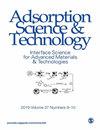Removal of Hexavalent Chromium by Using Sustainable Green Materials as Low-Cost Adsorbents
IF 3.2
4区 工程技术
Q2 CHEMISTRY, APPLIED
引用次数: 0
Abstract
The possibility of using three types of NaOH-treated tea residues (green tea, pu-erh, and tieguanyin) as low-cost adsorbents for Cr(VI) treatment was investigated. The surface charge, composition, morphology, structure, and functional groups in the obtained biosorbents were characterized by pHzpc, cellulose content, SEM, BET, XRD, and FTIR spectroscopy. The nonlinear pseudo-first-order, pseudo-second-order, and Elovich models were used to investigate adsorption kinetics at various initial concentrations. The adsorption processes were more consistent with the pseudo-second-order kinetic model in the range of 5-50 mg L-1. The adsorption isotherm at 298 K was described using the nonlinear Langmuir, Freundlich, Temkin-Pyzhev, and Dubinin-Radushkevich models, indicating that the process was favorable and complex with maximum adsorption amounts of 6.15, 19.50, and 12.31 mg g-1 for green tea, pu-erh, and tieguanyin residues, respectively. Thermodynamic analysis revealed that the adsorption was a spontaneous, endothermic process. The results demonstrated that all materials had the potential to successfully remove Cr(VI) from the aqueous solution.可持续绿色材料作为低成本吸附剂去除六价铬
研究了用三种naoh处理过的茶渣(绿茶、普洱茶和铁观音)作为低成本吸附剂处理Cr(VI)的可能性。通过pHzpc、纤维素含量、SEM、BET、XRD和FTIR等光谱对所得生物吸附剂的表面电荷、组成、形态、结构和官能团进行了表征。采用非线性拟一阶、拟二阶和Elovich模型研究了不同初始浓度下的吸附动力学。吸附过程在5 ~ 50 mg L-1范围内更符合准二级动力学模型。采用非线性Langmuir、Freundlich、Temkin-Pyzhev和Dubinin-Radushkevich模型描述了298 K下的吸附等温线,表明该过程有利且复杂,对绿茶、普洱茶和铁观音残留物的最大吸附量分别为6.15、19.50和12.31 mg g-1。热力学分析表明,吸附是一个自发的吸热过程。结果表明,所有材料都具有成功去除水溶液中Cr(VI)的潜力。
本文章由计算机程序翻译,如有差异,请以英文原文为准。
求助全文
约1分钟内获得全文
求助全文
来源期刊

Adsorption Science & Technology
工程技术-工程:化工
CiteScore
5.00
自引率
10.30%
发文量
181
审稿时长
4.5 months
期刊介绍:
Adsorption Science & Technology is a peer-reviewed, open access journal devoted to studies of adsorption and desorption phenomena, which publishes original research papers and critical review articles, with occasional special issues relating to particular topics and symposia.
 求助内容:
求助内容: 应助结果提醒方式:
应助结果提醒方式:


